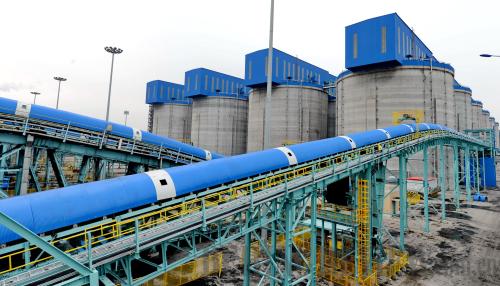|
 |
|
A FRESH APPROACH: Closed coal transmission lines are in full swing at a port in Huanghua City, north China's Hebei Province, on October 6. The port is an important transport hub for shipping coal from north China. But loading and transporting coal used to cause severe pollution in the city. Since 2010, the port has invested heavily on the construction of facilities that can greatly reduce pollution (MOU YU) |
Private Banks
The China Banking Regulatory Commission (CBRC), the country's banking regulator, said on September 29 that it had approved another two private banks, with one in Shanghai and the other in Zhejiang Province. The CBRC requires the banks to be established within six months from September 29.
A 30-percent stake of the Zhejiang-based bank will be funded by a micro-business financing company indirectly controlled by New York-listed Alibaba Group, China's largest e-commerce business. The Shanghai-based conglomerate Fosun Group will contribute 25 percent of funding, and China's largest auto parts supplier, Wanxiang Group, will hold an 18-percent stake in the new private bank.
The new Shanghai-based private bank will receive 30 percent of its funding from Juneyao Group, another Shanghai-based conglomerate, and 15 percent of its funding will come from Metersbonwe Group, a leading casual wear apparel company in China.
On July 25, the CBRC already approved the establishment of three private banks. Currently, China has only one private bank in service, China Minsheng Bank, which was founded in Beijing in 1996.
PMI Data
The manufacturing purchasing manager's index (PMI), a key measure of factory activity, posted at 51.1 in China in September, unchanged from August's reading, according to data released by the National Bureau of Statistics (NBS) and the China Federation of Logistics and Purchasing (CFLP).
A reading above 50 indicates expansion, while a reading below 50 represents contraction. The NBS manufacturing PMI samples 3,000 enterprises of various sizes nationwide.
Among the sub-indices of the PMI, the production sub-index posted at 53.6, up 0.4 percentage points from August, and was the second highest reading this year, coming in just behind to the 54.2 reading in July.
"The September PMI remained above the 50 threshold, which indicated no change to the basic trend of steady economic growth in the future," said Zhang Liqun, an economist at the Development Research Center of the State Council.
The rise of the production sub-index suggested a rebound of industrial growth last month, he added.
In September, the PMI of non-manufacturing sectors stood at 54 percent, down 0.4 percentage points from the previous month, according to the NBS and the CFLP.
Cai Jin, deputy head of the CFLP, said that the data showed China's overall non-manufacturing business activity grew steadily in September. Satisfactory performance in the construction sector and overall optimism suggested that investment support stable growth in the near term, he noted.
Budget Management
The State Council, China's cabinet, on October 8 unveiled an action plan for better budget management as part of efforts to build a more transparent and efficient fiscal and taxation system.
The long-awaited decision was seen as the first step in jump-starting a new round of broader fiscal and taxation reforms by 2020, as it tries to ensure all government revenue and spending is covered by the management system.
In the document, the State Council outlines seven reform tasks for the budget's drafting, implementation, transparency and supervision, ordering a clear division of roles between the government and the market.
A multi-year budget-balancing scheme will be introduced to better manage and control unused government expenditures in the fiscal year, while local government debt will be regulated more strictly to guard against fiscal risks, according to the plan.
Fiscal preferential measures need to be gradually withdrawn in sectors and areas where market forces can play their role, it said, adding that government expenditures outside the budget will be supervised in order to prevent corruption. | 